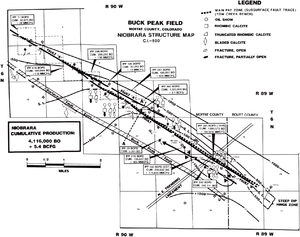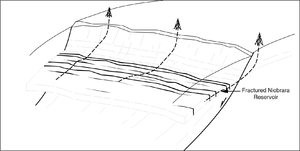Difference between revisions of "Critical elements application: Niobrara example"
Cwhitehurst (talk | contribs) |
FWhitehurst (talk | contribs) |
||
| Line 23: | Line 23: | ||
* Open calcite crystals lining the fractures | * Open calcite crystals lining the fractures | ||
* Well must penetrate above critical elements in a more fracturable (more calcareous) bench within the Niobrara | * Well must penetrate above critical elements in a more fracturable (more calcareous) bench within the Niobrara | ||
| − | * Completion must be [[Well completions#Open hole completions|open hole]] (hang a slotted liner) with cement-block fractures | + | * Completion must be [[Well completions#Open hole completions|open hole]] (hang a [[Well completions#Liner completions|slotted liner]]) with cement-block fractures |
* Drilling must be conducted with underbalanced mud or air to prevent fracture damage. The Niobrara is an underpressured reservoir with petrostatic (0.33 lb/ft gradient) rather than hydrostatic (0.43 lb/ft gradient) pressure. | * Drilling must be conducted with underbalanced mud or air to prevent fracture damage. The Niobrara is an underpressured reservoir with petrostatic (0.33 lb/ft gradient) rather than hydrostatic (0.43 lb/ft gradient) pressure. | ||
Revision as of 21:25, 20 February 2014
| Exploring for Oil and Gas Traps | |

| |
| Series | Treatise in Petroleum Geology |
|---|---|
| Chapter | Developing a philosophy of exploration |
| Author | Edward A. Beaumont, Norman H. Foster, Richard R. Vincelette, Marlan W. Downey, James D. Robertson |
| Link | Web page |
| Store | AAPG Store |
Critical elements of the Niobrara play
In the fractured Upper Cretaceous Niobrara play of the central Rocky Mountain region, specific critical elements must be present for a prospect to be successful. Since the Niobrara Formation is its own oil source rock, there is no bottom water; gas expansion along with gravity drainage provide the main reservoir energy, so the structural position of a well is not a critical factor. Synclines, anticlines, and any structural location in between will work. The main critical element is to find a sufficiently fractured sweet spot in which the fractures remain open during production. Careful study of numerous excellent Niobrara producing fields shows that the following critical elements must be present to achieve commercial success.
- Maximum bed curvature
- Normal fault cutting through area of maximum bed curvature
- Presence of a cross-lineation
- Open calcite crystals lining the fractures
- Well must penetrate above critical elements in a more fracturable (more calcareous) bench within the Niobrara
- Completion must be open hole (hang a slotted liner) with cement-block fractures
- Drilling must be conducted with underbalanced mud or air to prevent fracture damage. The Niobrara is an underpressured reservoir with petrostatic (0.33 lb/ft gradient) rather than hydrostatic (0.43 lb/ft gradient) pressure.
Applying the critical factors
Once the critical factors from the analog field(s) are fully understood, we can devise the best exploration methods to delineate the critical factors.
Niobrara structure
In the Niobrara play, a subsurface structure map on top of the Niobrara formation is a first step to locate areas of maximum bed curvature. Normal faults should then be mapped from subsurface well control, photogeology, and good old-fashioned field work. Cross-linears may be mapped from photogeology and satellite imagery. Figure 1 is an example Niobrara structure map.
Niobrara maximum bed curvature
Higher resistivity on electrical logs shows the brittle, more fracturable benches within the Niobrara. Constructing a detailed cross section, showing fracturable benches, maximum bed curvature, and any surface and subsurface normal faulting, allows the explorer to visualize and accurately plot the angle at which the well bore must be drilled to penetrate the critical elements.
Seismic surveys are not particularly helpful in mapping normal faults because they are listric with about 100-300 ft of throw at the surface and about 30-80 ft of throw in the Niobrara. The faults are usually not present below the Niobrara. Therefore, although the Mesa Verde provides good seismic marker beds, the underlying Mancos and Niobrara
Formations usually do not have them. Occasionally, upward-lying normal faults will produce. Seismic data are useful in delineating these faults because good marker beds are usually present below the Niobrara. The fault can then be projected upward and is sometimes associated with a dim spot due to attenuation of seismic data in fracture zones.
figure 2 is a Niobrara structure cross section.
Niobrara open fractures
Running samples on Niobrara wells will reveal whether open calcite crystals are present in the fractures. In addition, field work has shown that the same kind of calcite present in subsurface fractures within the Niobrara also occurs in fractures associated with brittle beds at the surface, such as the Mesa Verde group.
Surface geochemistry applied to Niobrara play
Surface geochemical methods—specifically, soil gas surveys—have proven useful in exploring for these types of traps. The computer compares hundreds of soil-gas ratios very quickly. Also, very sensitive chromatographs have improved the detection of vertical microseepages of hydrocarbons above these fractured reservoirs. The main method of exploration with this technique is to conduct surveys over a number of known commercial accumulations to establish productive signatures. Then a survey over the prospect may provide useful information that can be integrated with the other exploration techniques to help locate a drillsite.
Conclusion
Critical elements of the Niobrara play were identified by studying known accumulations. Knowing what elements were critical allowed a focused effort that saved time and improved effectiveness. Study known examples of trap types of interest to discover critical elements, and the result will be a more effective program.

